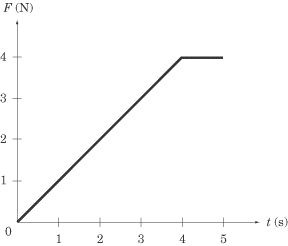Lesson: Chapter - 9
Impulse
The above version of Newton’s Second Law can be rearranged to define the
impulse, J, delivered by
a constant force, F. Impulse
is a vector quantity defined as the product of the force acting on a body and
the time interval during which the force is exerted. If the force changes during
the time interval, F is the
average net force over that time interval. The impulse caused by a force during
a specific time interval is equal to the body’s change of momentum during that
time interval: impulse, effectively, is a measure of change in momentum.
J = F?t = ?p
The unit of impulse is the same as the unit of momentum, kg · m/s.
Example
A soccer player kicks a 0.1 kg ball that is initially at rest so that it moves
with a velocity of 20 m/s. What is the impulse the player imparts to the ball?
If the player’s foot was in contact with the ball for 0.01 s, what was the force
exerted by the player’s foot on the ball?
What is the impulse the player imparts to the ball?
Since impulse is simply the change in momentum, we need to calculate the
difference between the ball’s initial momentum and its final momentum. Since the
ball begins at rest, its initial velocity, and hence its initial momentum, is
zero. Its final momentum is:
P = mv = (0.1 kg)(20 m/s)
=2kg.m/s
Because the initial momentum is zero, the ball’s change in momentum, and hence
its impulse, is 2 kg · m/s.
What was the force exerted by the player’s foot on the ball?
Impulse is the product of the force exerted and the time interval over which it
was exerted. It follows, then, that
F = J/?t.
Since we have already calculated the impulse and have been given the time
interval, this is an easy calculation:

Impulse and Graphs
subject test Physics may also present you with a force vs. time graph, and ask you to
calculate the impulse. There is a single, simple rule to bear in mind for
calculating the impulse in force vs. time graphs:
The impulse caused by a force during a specific time interval is equal to the
area underneath the force vs. time graph during the same interval.
If you recall, whenever you are asked to calculate the quantity that comes from
multiplying the units measured by the y-axis with the units measured by
the x-axis, you do so by calculating the area under the graph for the
relevant interval.
Example

What is the impulse delivered by the force graphed in the figure above between
The impulse over this time period equals the area of a triangle of height
4 and base 4
plus the area of a rectangle of height 4
and width 1. A quick calculation shows us
that the impulse is:

Back Next
Next to display next topic in the chapter.
Practice Questions
Video Lessons and 10 Fully Explained Grand Tests
Large number of solved practice MCQ with explanations. Video Lessons and 10 Fully explained Grand/Full Tests.